A few photos from a late arriving visitor to the University of Wisconsin’s Kohl Center.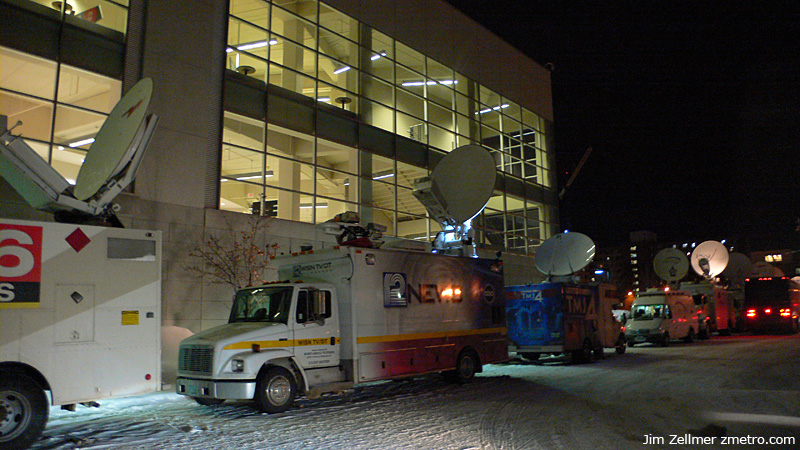
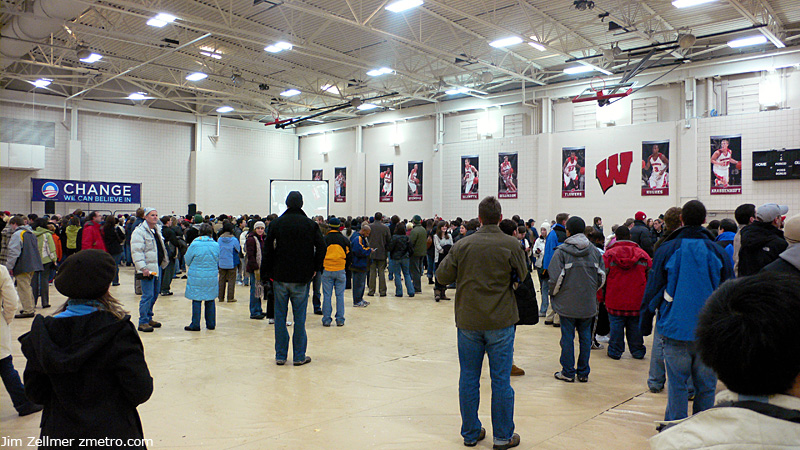
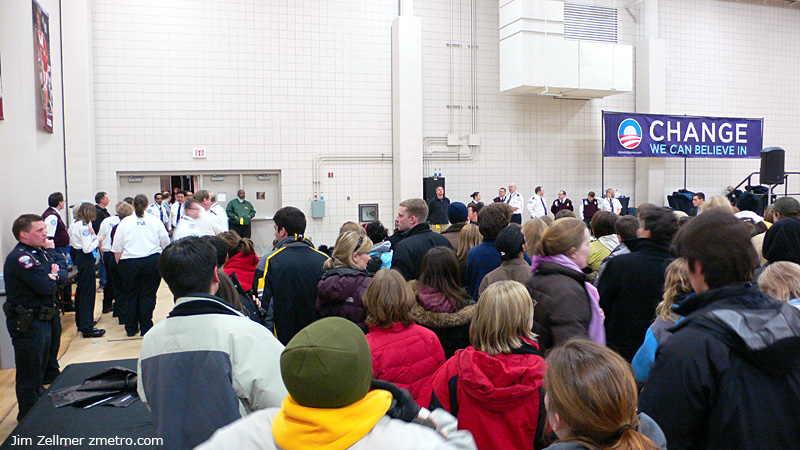
While I did not arrive early enough to catch the speech inside the Kohl Center, I always find it interesting to note the political opportunism during these events. Governor Doyle, Milwaukee Mayor Tom Barrett and local Mayor Dave Cieslewicz all rated a nod from Obama. John Kerry’s 2004 appearance with Bruce Springsteen included a number of local politicians, including Elizabeth Burmaster, Wisconsin Department of Public Instruction Superintendent (a nonpartisan position).
Finally, a few Ron Paul supporters promoted their candidate in front of the proceedings.
Category: Culture
Riding That Train, A Long Commute
At 6 on a Wednesday morning, Jim Bourgart is already 15 minutes into a 175-minute commute by foot, bus, train and foot again. From downtown San Francisco he’ll catch an Amtrak motor coach to the Emeryville station, where he’ll sit 20 minutes on a hard plastic bench waiting for the 6:40 to Sacramento.
He doesn’t mind as long as he is moving. It is the lost sleep time in the waiting room that hurts. Since the Capitol Corridor runs both the bus and the train, you’d think it could tighten the time-cushion allowed for traffic that never appears on the eastbound bridge.
“I could use those extra 20 minutes, or even 10 or 5,” says Bourgart, who starts his day with a 12-minute walk in the dark from his SoMa condo to the bus stop at the Market Street entrance to Bloomingdale’s. “Every minute counts, especially in the morning.”
The Capitol Corridor is a line made possible by the voters, who in 1990 approved Prop. 116 to provide state funding for intercity passenger rail service. Until 1998, there were only four trains each direction per day and the morning commute was essentially westbound only. Now there are 16 roundtrips. The State of California owns the rolling stock, Union Pacific owns the tracks, BART supplies administration, Amtrak staffs the trains and stations and a joint powers authority oversees it. The Capitol Corridor is like Caltrain with more layers of agencies.
Why Not?
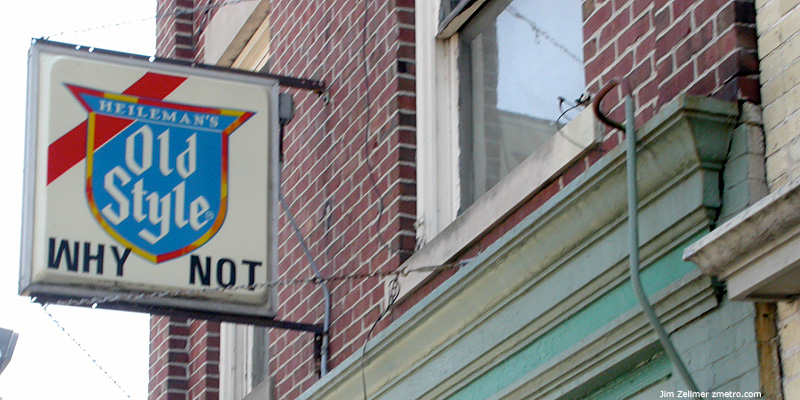 Classic Old Style beer sign with an appropriate tavern name.
Classic Old Style beer sign with an appropriate tavern name.
Thinking of Summer: Aix-en-Provence
 Thoughts of summer as Winter continues in Madison. Note the fashionable sushi delivery vehicle, a Smart Car and the smartly dressed pedestrian. Summer in Provence. Much more on Aix-en-Provence here [map]
Thoughts of summer as Winter continues in Madison. Note the fashionable sushi delivery vehicle, a Smart Car and the smartly dressed pedestrian. Summer in Provence. Much more on Aix-en-Provence here [map]
Technology’s Unintended Consequences
As GPS transceivers become common accessories in cars, the benefits have been manifold. Millions of us have been relieved of the nuisance of getting lost or, even worse, the shame of having to ask a passerby for directions.
But, as with all popular technologies, those dashboard maps are having some unintended consequences. In many cases, the shortest route between two points turns out to run through once-quiet neighborhoods and formerly out-of-the-way hamlets.
Scores of villages have been overrun by cars and lorries whose drivers robotically follow the instructions dispensed by their satellite navigation systems. The International Herald Tribune reports that the parish council of Barrow Gurney has even requested, fruitlessly, that the town be erased from the maps used by the makers of navigation devices.
A research group in the Netherlands last month issued a study documenting the phenomenon and the resulting risk of accidents. It went so far as to say that GPS systems can turn drivers into “kid killers.”
Carr makes an excellent point. One has to add some common sense to navigation systems. I used a TomTom in Europe last year. I found it very helpful – mostly, however, when we decided to wander around. The navigation system would then provide a route back to the hotel (which I had added as a predefined point prior to our departure).
33 Things That Make Us Crazy
Wired on air travel, and 32 other modern annoyance:
Ticket Counter: Expensive? If anything, flying doesn’t cost enough: The average domestic fare in spring 2007 was $326. That’s $50 less than a decade ago, after adjusting for inflation. During the same period, fuel costs nearly tripled. To stay in business, major carriers have aped the strategies of budget operators like Southwest. Largely gone are the free meals, blankets, and pillows. The savings have been passed along as lower ticket prices — at the price of your comfort.
Repress U
Free-speech zones. Taser guns. Hidden cameras. Data mining. A new security curriculum. Private security contractors. Welcome to the homeland security campus.
From Harvard to UCLA, the ivory tower is fast becoming the latest watchtower in Fortress America. The terror warriors, having turned their attention to “violent radicalization and homegrown terrorism prevention”–as it was recently dubbed in a House of Representatives bill of the same name–have set out to reconquer that traditional hotbed of radicalization, the university.
Building a homeland security campus and bringing the university to heel is a seven-step mission:
1. Target dissidents. As the warfare state has triggered dissent, the campus has attracted increasing scrutiny–with student protesters in the cross hairs. The government’s number-one target? Peace and justice organizations.
From 2003 to 2007 an unknown number of them made it into the Pentagon’s Threat and Local Observation Notice system (TALON), a secretive domestic spying program ostensibly designed to track direct “potential terrorist threats” to the Defense Department itself. In 2006 the ACLU uncovered, via Freedom of Information Act requests, at least 186 specific TALON reports on “anti-military protests” in the United States–some listed as “credible threats”–from student groups at the University of California, Santa Cruz; State University of New York, Albany; Georgia State University; and New Mexico State University, among other campuses.
At more than a dozen universities and colleges, police officers now double as full-time FBI agents, and according to the Campus Law Enforcement Journal, they serve on many of the nation’s 100 Joint Terrorism Task Forces. These dual-purpose officer-agents have knocked on student activists’ doors from North Carolina State to the University of Colorado and, in one case, interrogated an Iraqi-born professor at the University of Massachusetts about his antiwar views.
For Champions of Haggling, No Price Tag Is Sacred
MY husband and I hate haggling. In markets in Istanbul or Jerusalem or Florence, where arguing over price is a high art — and after we have given it our best shot — we always feel we have walked away paying twice as much as the seller expected.
And that they are secretly, or not so secretly, laughing at us.
In this country where you are expected to negotiate over cars and houses, we manage quite well, but do not find it fun or exciting. We just want it to be over.
But I have friends who always seem able to strike a great deal in unexpected areas. My friend Lou negotiates a lower price on the oil delivered to his house. On his credit card rates. On hotel rooms. At the gym.
“People are afraid to ask, afraid they’ll be embarrassed or afraid they won’t get the right answer,” he said. “Seventy-five percent of the time, I get the right answer.”
Lou and other successful hagglers are not worried about appearing cheap, as I am, or being turned down, because they start with a different attitude.
Ubiquitous Packer Paraphernalia
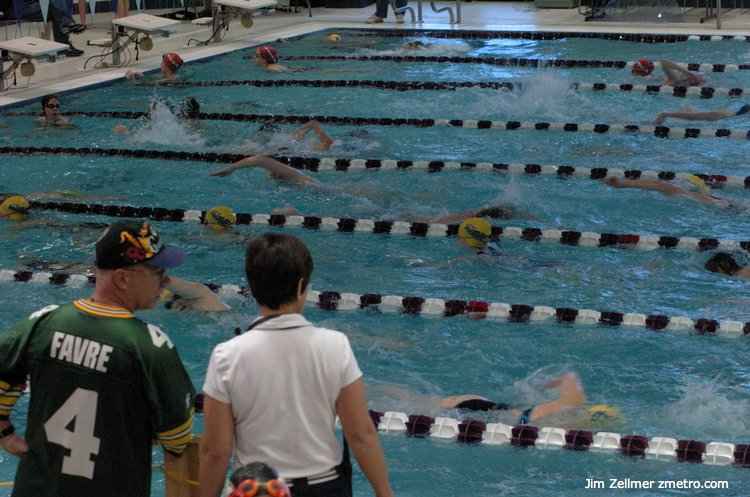
>
This photo was snapped at an early morning swim meet this weekend.
All Roads Still Lead to Lombardi
All you need to know about Green Bay is that Lambeau Field is on Lombardi Avenue.
Even the numerals in the Packers’ address, 1265 Lombardi Avenue, are significant — 12 for the franchise’s record number of N.F.L. championships, 6 when Curly Lambeau was the coach, 5 when Vince Lombardi was the coach. The 1996 team won the other title in Super Bowl XXXI with Mike Holmgren as the coach (he later defected to Seattle) and Brett Favre at quarterback (he is still the face of the franchise). But Lambeau and Lombardi remain its cornerstones.
Lambeau, a star tailback at Green Bay East High School who left Notre Dame after a year, organized the original Packers team at a meeting in the dingy Press-Gazette newspaper offices in 1919 when a local meatpacking company put up $500 for uniforms and pro football was a small-town sport.
Lombardi, a New Yorker originally out of Sheepshead Bay, St. Francis Prep and Fordham before coaching at St. Cecilia’s in Englewood, N.J., at Army under Red Blaik and the Giants’ offense for five seasons (including the 1956 championship team), gilded Green Bay with a major league mystique.
